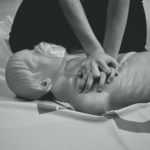You can tell that John and Christopher Di Capua are bright young men with the ambition to help people and make CPR more efficient and effective. What started as a high school research project has now turned into a product with a purpose to save lives. CPR is a lifesaving skill, but oftentimes, people get tired, or there is only one rescuer. The product they invented made both of these problems all but obsolete.
“Less than 10 percent of people who get CPR from a bystander live to tell about it. Nearly 400,000 people every year — more than 1,000 every day — receive CPR from a bystander,” notes an article from USA Today. The statistics are daunting, but they should never keep us from performing CPR on someone; you never know if the person you help will be the one to live.
“We wanted to see if we could do something to improve bystander CPR survival rates through improved technique,” John Di Capua said. “Even if we could improve the percentage slightly, it would mean a lot more lives are saved.” So, he and his brother built a device called AVAC. It stands for Automatic Ventilation with Assisted Compressions, and they created it for less than $150. The device automatically forces oxygen directly into the lungs of a person in cardiac arrest. This frees up the rescuer to only have to do chest compressions or use a defibrillator. Mouth-to-mouth resuscitation, something a lot of people are afraid of, is no longer needed.
So, where did this whole project start?
It turns out, both brothers were in the Authentic Science Research Program, which is a three year project that takes place at Byram Hills High Schoool. John started in 2007, comparing three different ways of getting air into the body. There is mouth-to-mouth ventilation, bag valve mask ventilation, and an I-gel. (A soft, silicone tube inserted into the throat to make an airway.)
According to John’s research, an I-gel is the “easiest and most effective way for an untrained bystander to deliver air to the body.” Once he figured that out, he made a machine connecting the I-gel to an oxygen canister as well as a battery-operated control panel. The panel activates the machine to pump 14 breathes of air every minute.
The result of his work?
A place as a semi-finalist in the Intel Science Talent Search. After he graduated in 2010, his brother Chris entered the program and finished the device. He also set out to discover if people would actually use it to give CPR. He showed untrained participants a video explaining how to use the device to perform CPR. Then he asked the participant to use it on a mannequin.
“Most people could do it,” said John. Following his brother, he also earned a semi-finalist’s spot in the Intel Science Talent Search. Although there are other students from Byram Hills who have merited this recognition, adviser David Keith is not aware of anyone besides the Di Capua brothers who also have a patent for their work. “It’s a real validation of what is latent in so many young people in terms of their intellectual horsepower and creativity and their willingness to work for something they believe in,” Keith said.
Where are they now?
John recently earned his undergraduate degree at John Hopkins University in Baltimore. He’s planning on taking a year to get his master’s degree in public health, then it’s off to medical school. Chris recently finished the first of eight years at Union college. The result will hopefully be an undergraduate degree, a masters’ degree in business administration, and medical school as well. Ambitious plans; no wonder they got a patent for their CPR device!
It is the brothers’ hope that they can interest a medical device company in AVAC, and they want their invention to be paired with AEDs in public places where they can be of help to people in the future.
There are definite upsides to this new invention: it will only take one rescuer to perform breaths and compressions at the same time. You never have to pause compressions to begin breaths, you just pump away at the chest. By the way, there’s a light that gives you a metronome-like rythym by which to perform compressions, so you never have to worry about doing them too fast or too slow. You won’t get tired of breathing with AVAC, because it does it for you. Finally, it only costs $150.
If this innovative invention catches on, the future is bright for these two young men with a mission to make a good CPR system even better.
Source: USA Today







Comments
Kelly Andersen liked this on Facebook.
Kimmie Addicott liked this on Facebook.
To make CPR more efficient & effective is outstanding. Congrats to the high school brothers on their patented invention, especially when it started as a high school research project. With this, thousands of lives will be saved.